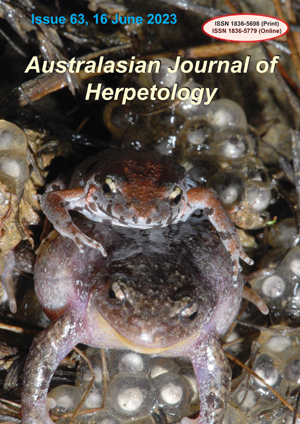 WTF? - New species of frogs discovered in Melbourne and Victoria.
WTF? - New species of frogs discovered in Melbourne and Victoria.Media release 16 June 2023.
 WTF? - New species of frogs discovered in Melbourne and Victoria.
WTF? - New species of frogs discovered in Melbourne and Victoria.
This week saw something come from left of field in the world of science.
Several new species of frogs were discovered and named in Australia.
This included one of the most common frogs found in Melbourne, Victoria, Australia and one that will be familiar to home-owners across the southern capital.
Named in honour of former News Corporation journalist Fia Cumming, Crinia fiacummingae a tiny frog from Melbourne and environs was found to have diverged from its nearest relative, a previously named species from north-west Tasmania by more than 5 million years.
Australia’s foremost reptile and frog expert, the Snakeman Raymond Hoser noted that Crinia fiacummingae was even more divergent from another near relative, Crinia signifera, from Sydney, New South Wales, the species it was usually confused with.
This tiny little brown coloured froglet is by far the most commonly seen small frog around Melbourne and environs being found even in inner suburbs.
It commonly frequents ponds, soaks, roadside ditches and other places water accumulates in the winter months.
However Crinia fiacummingae is not the only tiny frog found in the Melbourne area.
Other species Crinia parainsignifera and Geocrinia victoriana (both common on the northern fringes of Melbourne and Paracrinia lenhoseri from the lower Mornington Peninsula, are all very similar in size and appearance. A close inspection by someone who knows their frogs is needed to tell these tiny species of frogs apart.
They all also have different mating calls.
Hoser noted that it had been known for several years that there remained unnamed species of Crinia, so to claim they were wholly discovered by himself may be stretching things a bit, even though the person who first names a species is generally credited with discovering it.
In Hoser’s words “nobody really gave a shit! They were tiny, common, ugly and about as unsexy a frog as one can find”.
In years past, numerous forms within the C. signifera species complex had been named and nobody had really bothered to tease the forms apart or to determine which if any of the other “available” names were applicable to other distinctive forms.
On final analysis, Hoser said he was surprised that in 2023, any forms of putative C. signifera were unnamed and so to find four good species with divergences in excess of 5 million years from one another that were unnamed, was quite a rude shock!
In his paper published this week (June 2023), Hoser found that the type form of C. signifera from most parts of eastern New South Wales was the first named member of the group. The name C. varius (Peters, 1863) could be applied to specimens from South Australia in the general region of Adelaide and C. englishi (Parker, 1940) was from Tasmania.
Four other obvious species, with divergences estimated at more than 5 MYA from their nearest relatives remained unnamed and were named by Hoser, as well as two very divergent forms he formally named as subspecies of C. signifera. Having named about 90 species of frog from Australia, Raymond Hoser has named more than 1 in four species of Australian frog, including species from all States and mainland territories.
Having named about 90 species of frog from Australia, Raymond Hoser has named more than 1 in four species of Australian frog, including species from all States and mainland territories.
Recently a frog enthusiast named Michael Mahony from Newcastle in New South Wales has been engaging in what is known as “Taxonomic vandalism” by renaming species already named by Raymond Hoser, by coining his own pseudoscientific names.
Besides breaching the Copyright Act 1968, Mahony’s actions are in breach of the International Code of Zoological Nomenclature, which is the rule book that binds all scientists globally.
The correct names to be used are the earlier names of Hoser and not recently coined duplicate names for the same species that Mahony has decided to peddle online.
Mahony’s actions have affected two Victorian species, namely Philocryphus hoserae Hoser, 2019 and Mixophyes hoserae Hoser, 2020.
In the case of the latter species, he attempted to rename it in June 2023 and lied to the media by claiming to have discovered the species. He called it “Mixophyes australis” . Because it is a duplicate of Mixophyes hoserae Hoser, 2020, the Mahony name should not be used.
It also happens to be by far the largest species of frog in Victoria, being known from the northeast of the State and nearby coast and ranges of New South Wales to the lower North Coast.
The species is also in precipitous decline due to an exotic fungus.
Hoser said that if Mahony was genuinely interested in frogs and their welfare, he would not be wasting people’s time coining illegal duplicate names for these frogs, but instead be working for the conservation of the species and educating others of their plight.
Further information and photos of the relevant frogs from the Snakeman Raymond Hoser on 0412777211
snakeman@snakeman.com.au
To download a dated phylogeny of the relevant species click here. BTW The mating frogs on the cover of AJH Issue 63 are Geocrinia otwaysensis (Hoser, 2020) a species discovered and named by the Snakeman Raymond Hoser in 2020 and one of the more common species in the Otway Ranges, south-west Victoria.
BTW The mating frogs on the cover of AJH Issue 63 are Geocrinia otwaysensis (Hoser, 2020) a species discovered and named by the Snakeman Raymond Hoser in 2020 and one of the more common species in the Otway Ranges, south-west Victoria.